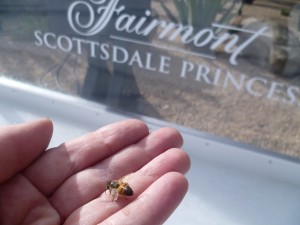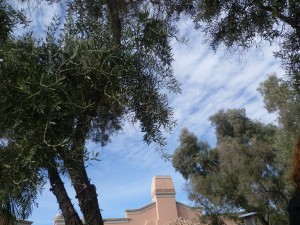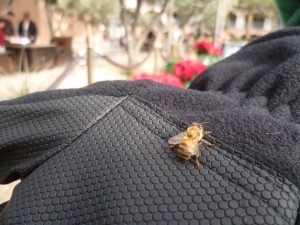On a recent visit to Scottsdale, Arizona I sought out a Fairmont Hotels & Resorts property for its luxurious surroundings and unrivalled presence. Given the company’s reputation for bringing urban beekeeping to inn keeping I had half expected to also find a hive of activity on site. The few days I spent there were absolutely fantastic. The hotel even had an outdoor ice skating rink for me to spend a day on, but alas there was not an apiary to be found. 
We ventured out on our first morning for an outdoor patio breakfast. The weather was unseasonably cool and I was thankful for having packed my Canada Goose bomber. Just as I was asking the server about any neighbouring bees, a lone worker honeybee floated to our table. The server subsequently advised me that there were no hives on site. I assumed that the bee must have taken flight from a neighbouring bee yard. Had it been lured, from its early morning flight path, by the warm tableside flame that flickered from an opening in the table’s centre? Or did it sense the pheromone of a Toronto urban queen? 
Twenty-four hours prior to my arrival in Arizona I had checked on the hives wintering on the roof of Toronto’s Fairmont Royal York. The city had just had its first snowfall and I wanted to be sure they were wrapped for winter. They were fine and given the cool temperatures I was certain that the bees inside had officially clustered together to maintain their body temperatures while inside the hive. To this end, I was quite intrigued by my breakfast with an Arizona honeybee. She was free of the confines of the hive and had a warmer climate to enjoy a day of foraging.
Little did I know of the danger that lurked nearby for her and the rest of her colony. It was the hotels nearby ice skating rink, which would soon to prove to be a menacing death trap for the bees. The stark white ice of the outdoor rink glistened in the sun while tall cacti cast dark Gumby-like shadows on its corners. It all appeared harmless upon my first glance and my first glide. That was until I heard several little girls squeal “ooh dead bees, ooh dead bees on the ice.”
I instantly thought to myself that the bees couldn’t have possibly chosen their icy grave. Bees like to land on warm colorful juicy locations. I assumed that their untimely death must have been caused by their inability to see white. (It is for this reason that white apparel is always in fashion for beekeepers) I investigated further by skating over to a clump of dead workers and gently cupped a few in my hands.
Within five minutes of study I discovered that they were not clinically dead—they were just cold. As I held them in my hand the warmth of my body transferred to the bees and soon they resumed their flight path back to their hive. 
I advised the groundskeeper to regularly sweep the ice and scatter all the frozen bees onto the neighbouring grass. This option would surely protect future bees from going under the blade. He agreed and was equally fascinated by the bee rescue on ice. It was a magical moment in the Arizona desert.
A fellow Ontario beekeeper had a similar experience and you may learn of it here: http://thebeejournal.blogspot.ca/2010/01/lazarus-come-forth.html 
Do you know what Regional Heterothermy is?
According to Wikipedia: “Regional heterothermy describes organisms that are able to maintain different temperature “zones” in different regions of the body. There are even some insects which possess this mechanism, the best-known example being bumblebees, which exhibit counter-current heat exchange at the point of constriction between the thorax and abdomen; heat is retained in the thorax and lost from the abdomen. Using a very similar mechanism, the internal temperature of a honeybee‘s thorax can exceed 45°C while in flight.”
